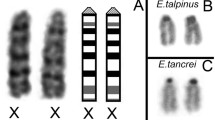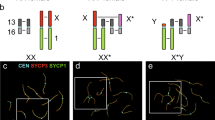Summary
Sex chromosome length, sex chromatin area and the pattern of sex chromosome replication were determined in the field mouseAkodon azarae (Rodentia Cricetidae). Among the animals studied a group of spontaneously deleted females was included. The complemont in deleted females was 38Xx, being the x a grossly deleted X-chromosome.
Length of sex chromosomes expressed as percentage of the haploid set was: X-chromosome 7.89% (±1.18), x-chromosome 1.47% (±0.20), Y-chromosome 1.15% (±0.29). Area of sex chromatin expressed as percentage of the haploid genome was 7.28% (±1.18) in XX females and 3.26% (±0.73) in Xx females. According to these data it was assumed that: (a) sex chromatin was formed by all those sex chromosome material in excess of the 5% of the haploid set; (b) the x-chromosome in Xx females was always involved in sex chromatin formation.
Time-sequence of sex chromosome replication was as follows: (a) at the beginning of the S period one X-chromosome starts replication carly while the other X, the x and the Y-chromosomes are the last to initiate DNA synthesis; (b) in the intermediate stage of the S period sex chromosomes replicate in the same way as autosomes; (c) in late and final stages of the S period both sex chromosomes are late replicating in their whole extension. It is concluded that the pattern of sex chromosome replication at the beginning of the S period may be more informative than the pattern at the end of the S phase to distinguish between hetero-and euchromatin in the sex genome ofAkodon azarae.
Zusammenfassung
An der FeldmausAkodon azarae wurde die Länge der Geschlechtschromosomen, die Größe des Geschlechtschromatinkörperchens und das Muster der Geschlechtschromosomenreplikation bestimmt. Unter den untersuchten Tieren befand sich auch eine Gruppe von Weibchen mit einem spontan deletierten X-Chromosom. Der Karyotyp dieser Weibchen war 38 Xx, wobei x das stark deletierte X-Chromosom darstellt.
Die Länge der Geschlechtschromosomen wurde wie folgt, ausgedrückt in Prozent des haploiden Satzes, ermittelt: X-Chromosom 7,89% (±1,18), x-Chromosom 1,47% (±0,20), Y-Chromosom 1,15% (±0,29). Die Größe des Geschlechtschromatinkörpers, ausgedrückt in % des haploiden Genoms, betrug 7,28% (±1,18) bei XX-Weibchen und 3,26% (±0,73) bei Xx-Weibchen. Auf Grund dieser Daten wird angenommen, daß a) das Geschlechtschromatin durch das gesamte Geschlechtschromosomenmaterial, das 5% des Haploidsatzes übersteigt, gebildet wird, und b) das x-Chromosome bei den Xx-Weibchen stets an der Geschlechtschromatinbildung beteiligt ist.
Die Geschlechtschromosomenreplikation ging zeitlich wie folgt vor sich: a) zu Beginn der S-Periode beginnt ein X-Chromosom früh mit der Replikation, während das andere X-Chromosom und das x- und Y-Chromosom die DNS-Synthese als letzte beginnen; b) im intermediären Stadium der S-Periode replizieren die Geschlechtschromosomen in gleicher Weise wie die Autosomen, c) in den späten und endstadien replizieren beide Geschlechtschromosomen in ihrer gesamten Ausdehnung spät. Das Muster der Chromosomenreplikation zu Beginn der S-Periode kann als aufschlußreicher für die Unterscheidung von Hetero- und Euchromatin im Geschlechtsgenom vonAkodon azarae angesehen werden als das Replikations-Muster der Endphase.
Similar content being viewed by others
Literature Cited
Bianchi, N. O., andM. S. A. de Bianchi: DNA replication sequence of human chromosomes in blood cultures. Chromosoma (Berl.)17, 273–290 (1965).
Bianchi, N. O., andM. S. A. de Bianchi: Shifting in the duplication time of sex chromosomes in the rat. Chromosoma (Berl.)19, 286–299 (1966).
Bianchi, N. O., andJ. Contreras: The chromosomes of the field mouseAkodon azarae (Cricetidae Rodentia) with special reference to sex chromosome anomalies. Cytogenetics6, 303–313 (1967).
Bianchi, N. O., A. Lima-de-Faria andH. Jaworska: A technique for removing silver grains and gelatine from tritium autoradiographs of human chromosomes. Hereditas (Lund)31, 207–211 (1964).
Bianchi, N. O., andJ. Molina: Autosomal polymorphism in a laboratory strain ofRattus norvegicus. J. Hered.57, 231–232 (1966).
Chicago Conference: Standardization in Human Cytogenetics. Birth Defects: Original article series II: 2 (1966). The National Foundation, New York.
Grumbach, M. M., P. A. Marks andA. Morishima: Erythrocyte glucose-6-phosphate dehydrogenase activity and X-chromosome polysomy. LancetI, 1330–1331 (1962).
Grumbach, M. M., A. Morishima andJ. H. Taylor: Human sex chromosome abnormalities in relation to DNA replication and heterochromatinization. Proc. nat. Acad. Sci. (Wash.)49, 381–389 (1963).
Hsu, T. C.: Mammalian chromosomesin vitro XVIII. DNA replication sequence in Chinese hamster. J. Cell Biol.25, 53–62 (1964).
Ohno, S.: Sex chromosomes and sex linked genes. Berlin: Springer-Verlag 1967.
Ohno, S., W. Beçak andM. L. Beçak: X-autosome ratio and the behaviour pattern on individual X-chromosomes in placental pammals. Chromosoma (Berl.)15, 14–30 (1964).
Sisken, J. E.: Methods for measuring the length of the mitotic cycle and the timing of DNA synthesis for mammalian cells in culture. In: Methods in cell physiology, p. 387–401. New York: Academic Press 1964.
Vrba, M.: Idiogram of the rat (Rattus norvegicus) and reliability in identification of individual chromosomes. Folia Biol. (Prague)10, 75–80 (1964).
Author information
Authors and Affiliations
Rights and permissions
About this article
Cite this article
Bianchi, N.O., Dulout, F.N. & Contreras, J. Sex chromosome replication and sex chromatin inAkodon azarae (Rodentia Cricetidae) . Theoret. Appl. Genetics 38, 343–347 (1968). https://doi.org/10.1007/BF00934165
Issue Date:
DOI: https://doi.org/10.1007/BF00934165




